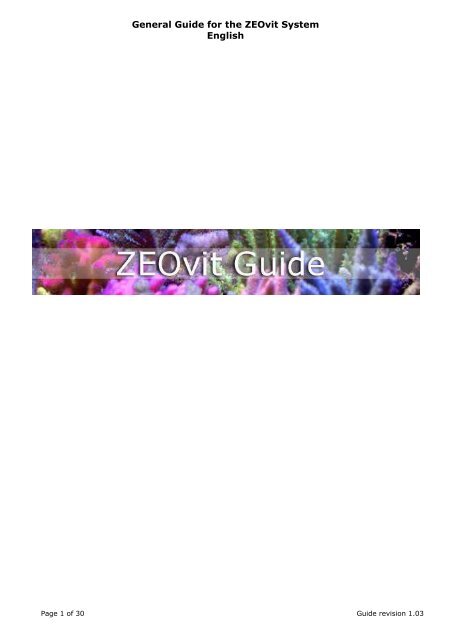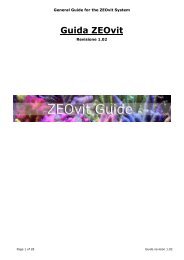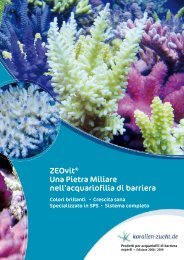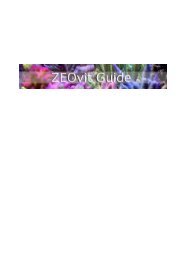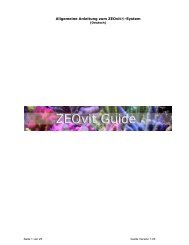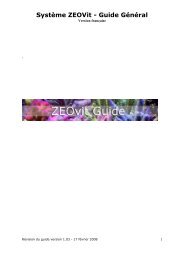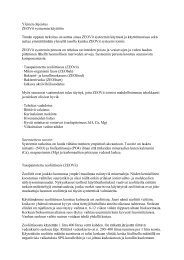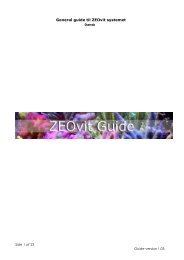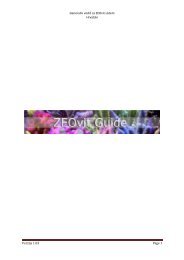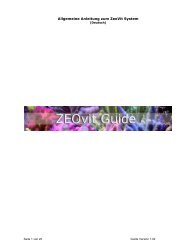General Guide for the ZEOvit System English - Korallen-Zucht.de
General Guide for the ZEOvit System English - Korallen-Zucht.de
General Guide for the ZEOvit System English - Korallen-Zucht.de
You also want an ePaper? Increase the reach of your titles
YUMPU automatically turns print PDFs into web optimized ePapers that Google loves.
<strong>General</strong> <strong>Gui<strong>de</strong></strong> <strong>for</strong> <strong>the</strong> <strong>ZEOvit</strong> <strong>System</strong><br />
<strong>English</strong><br />
Page 1 of 30 <strong>Gui<strong>de</strong></strong> revision 1.03
<strong>General</strong> <strong>Gui<strong>de</strong></strong> <strong>for</strong> <strong>the</strong> <strong>ZEOvit</strong> <strong>System</strong><br />
<strong>English</strong><br />
Table of Contents<br />
Introduction 2<br />
1. Balanced mix of zeolites (<strong>ZEOvit</strong>®) 4<br />
2. Microorganism solution (ZEObac) 8<br />
3. Combination product of bacteria and coral food (ZEOfood7) 10<br />
4. Bacteria food (ZEOstart2) 12<br />
5. Constant filtration with activated carbon 14<br />
6. Efficient strong skimming 16<br />
7. Sufficient Lighting 16<br />
8. Optimization of nutrient addition 17<br />
9. Addition of elements at low levels 17<br />
Potassium iodi<strong>de</strong> / fluori<strong>de</strong> concentrate: 18<br />
Iron Concentrate 19<br />
Macro element solution (ZEOspur Macroelements concentrate) 19<br />
Stylo-Pocci-Glow 20<br />
Amino Acid High Concentrate 20<br />
Amino Acid Concentrate LPS 21<br />
Trace element solution (ZEOspur2) 21<br />
Pohl’s Coral Vitalizer 22<br />
Pohl’s Coral Snow 23<br />
B-Balance 24<br />
K-Balance & K-Balance Strong 24<br />
Potassium K+Test 25<br />
10. Optimum water parameters (Ca, Mg, K+, KH, salinity) 26<br />
Reefer’s Best Salt 28<br />
11. Regular weekly water changes 29<br />
12. Sufficient Water Flow 29<br />
13. Use of Live Rock, etc. 29<br />
Page 2 of 30 <strong>Gui<strong>de</strong></strong> revision 1.03
<strong>General</strong> <strong>Gui<strong>de</strong></strong> <strong>for</strong> <strong>the</strong> <strong>ZEOvit</strong> <strong>System</strong><br />
<strong>English</strong><br />
The intent of this “gui<strong>de</strong>” is to assist you during <strong>the</strong> start-up phase and general use of<br />
<strong>the</strong> <strong>ZEOvit</strong>® system (by <strong>Korallen</strong>-zucht.<strong>de</strong>), as well as to give you a basic un<strong>de</strong>rstanding<br />
of how <strong>the</strong> system works.<br />
The system consists of two columns, which are <strong>de</strong>scribed as follows:<br />
Column 1 is <strong>the</strong> base system consisting of components to minimize nutrient levels.<br />
Column 2 <strong>de</strong>als with coral coloration and food in a nutrient poor system while<br />
maintaining “near natural” conditions.<br />
The base system involves <strong>the</strong> effective reduction of nutrients and maintenance<br />
of water conditions close to <strong>the</strong> parameters corals encounter in <strong>the</strong>ir natural<br />
habitat. This column consists <strong>for</strong> <strong>the</strong> following components:<br />
1. Balanced mix of zeolites (<strong>ZEOvit</strong>®)<br />
2. Microorganism solution (ZEObac)<br />
3. Combination product of bacteria and coral food (ZEOfood7)<br />
4. Bacteria food (ZEOstart)<br />
5. Constant filtration with activated carbon<br />
The following requirements are also necessary <strong>for</strong> <strong>the</strong> <strong>ZEOvit</strong>® method to be<br />
successful:<br />
6. Efficient strong skimming<br />
7. Sufficient lighting<br />
8. Optimization of nutrient addition<br />
9. Addition of elements at low levels<br />
10. Optimum water parameters (Ca, Mg, K+, KH, salinity)<br />
11. Regular weekly water changes<br />
12. Sufficient water flow<br />
13. Use of live rock etc.<br />
The goal to be achieved:<br />
The purpose of <strong>the</strong> system is to create a low nutrient, near natural levels, environment.<br />
The goal is to reduce measurable levels of nitrate (NO3) and phosphate (PO4) without<br />
lowering <strong>the</strong> levels of important minerals, like calcium (Ca), magnesium (Mg),<br />
Potoassium (K+) and carbonate hardness (KH), such that addition of <strong>the</strong>se trace<br />
elements is minimal.<br />
Page 3 of 30 <strong>Gui<strong>de</strong></strong> revision 1.03
<strong>General</strong> <strong>Gui<strong>de</strong></strong> <strong>for</strong> <strong>the</strong> <strong>ZEOvit</strong> <strong>System</strong><br />
<strong>English</strong><br />
1. Balanced mix of zeolites (<strong>ZEOvit</strong>®)<br />
Zeolites are a group of natural occurring minerals that exist worldwi<strong>de</strong>. Their chemical<br />
composition can vary greatly and <strong>the</strong>re<strong>for</strong>e exhibit different properties of adsorption, ion<br />
exchange or molecular retention. Today’s mo<strong>de</strong>rn industrial applications require very<br />
specific properties and <strong>the</strong>re<strong>for</strong>e most of <strong>the</strong> zeolites used are ei<strong>the</strong>r modified natural<br />
zeolites or completely syn<strong>the</strong>tically manufactured.<br />
Our mix consists of three different zeolites. These zeolites were chosen because of <strong>the</strong>ir<br />
ability to reduce certain toxins in a balanced manner. The functional life of <strong>the</strong> mix is<br />
limited and has to be exchanged every 6-12 weeks <strong>de</strong>pending on <strong>the</strong> tanks nutrient<br />
load. The replacement of old zeolite material with new can be conducted in a single<br />
session. The useful life is directly related to <strong>the</strong> tanks nutrient level. The higher <strong>the</strong><br />
load of organic compounds (phosphate - PO4 and nitrate - NO3), a shorter interval <strong>for</strong><br />
material exchange is required.<br />
It is important to have sufficient water flow through <strong>the</strong> filter material (200-400 liters<br />
per 1 liter of <strong>ZEOvit</strong>®). We strongly recommend not exceeding <strong>the</strong> maximum<br />
flow rate of 100 gph per 1 liter of <strong>ZEOvit</strong>®, which could undoubtedly have a<br />
negative impact. High water flow through <strong>the</strong> media in already stocked tanks,<br />
especially during <strong>the</strong> start up of this system, has shown to cause slow tissue loss in SPS<br />
corals. We recommend a lower flow rate through <strong>the</strong> media during <strong>the</strong> first few<br />
weeks of introduction of this method to a tank already stocked with corals. The<br />
effectiveness of this system in reducing nutrients could result in changes that are to<br />
abrupt when higher flow rates are used. However, corals need time to “adapt” to <strong>the</strong>se<br />
new nutrient conditions.<br />
We also recommend against use of phosphate absorbers, no matter if iron or aluminum<br />
based, when using this system. The system by itself is able to lower and maintain low<br />
levels of PO4 very effectively.<br />
The amount of <strong>ZEOvit</strong>® used is 1 liter per 100 gallons of water. It is important not to<br />
exceed this recommen<strong>de</strong>d amount, because excessive amounts of <strong>ZEOvit</strong>® could have a<br />
negative effect on SPS corals and lead to tissue necrosis and <strong>the</strong>re<strong>for</strong>e coral <strong>de</strong>ath.<br />
Signs of overdose are tissue loss starting from <strong>the</strong> coral tips or <strong>the</strong> complete loss of all<br />
tissue within a short period of time (i.e., rapid tissue necrosis, RTN). This problem<br />
occurs usually because of <strong>the</strong> rapid change in nutrient conditions in <strong>the</strong> tank. As<br />
mentioned above, corals need time to adapt to changes and an overdose does not allow<br />
Page 4 of 30 <strong>Gui<strong>de</strong></strong> revision 1.03
<strong>General</strong> <strong>Gui<strong>de</strong></strong> <strong>for</strong> <strong>the</strong> <strong>ZEOvit</strong> <strong>System</strong><br />
<strong>English</strong><br />
<strong>for</strong> gradual changes. In or<strong>de</strong>r to calculate <strong>the</strong> required amount of material, take <strong>the</strong><br />
gross water volume of <strong>the</strong> total system and subtract approximately 20% <strong>for</strong> an average<br />
<strong>de</strong>corated tank to come up with <strong>the</strong> net water volume. Use this net water volume to<br />
<strong>de</strong>termine <strong>the</strong> required amount of <strong>ZEOvit</strong>®.<br />
We recommend using only 60% of <strong>the</strong> required material <strong>for</strong> <strong>the</strong> first interval if your<br />
corals display high levels of zooxan<strong>the</strong>llae (i.e., dark brown with dull tissue appearance<br />
because of unnaturally high nutrient load).<br />
Rinse <strong>the</strong> <strong>ZEOvit</strong>® material very well with fresh water be<strong>for</strong>e use so that fine particles<br />
created by abrasion during transportation are removed. An initial cloudiness in <strong>the</strong><br />
water during introduction of new material is not harmful to living organisms and usually<br />
disappears within an hour.<br />
It is important to clean <strong>the</strong> material daily to maintain optimum per<strong>for</strong>mance. The filter<br />
specifically <strong>de</strong>signed <strong>for</strong> <strong>the</strong> system makes it possible to accomplish this task within a<br />
minute. The filter system consists of a cylindrical tube in which water from <strong>the</strong> tank<br />
flows from <strong>the</strong> bottom to <strong>the</strong> top. The <strong>ZEOvit</strong>® material is placed on top of a per<strong>for</strong>ated<br />
plate, which is connected to a PVC rod. To clean <strong>the</strong> material, push and pull <strong>the</strong> rod<br />
(about 2-4 inches) approximately 10 – 15 times. Keep <strong>the</strong> filter pump running during<br />
this cleaning process. If possible, we recommend doing this cleaning once or twice<br />
daily. It is not <strong>de</strong>trimental, if you are unable to per<strong>for</strong>m this task <strong>for</strong> several days.<br />
Return to <strong>the</strong> regular cleaning schedule as soon as possible. Suitable filters can be<br />
obtained from us or from one of our <strong>de</strong>alers.<br />
The mulm, released from <strong>the</strong> <strong>ZEOvit</strong>® material, contains bacteria that are used as food<br />
by <strong>the</strong> corals. We <strong>the</strong>re<strong>for</strong>e recommend placing <strong>the</strong> <strong>ZEOvit</strong>® filter after <strong>the</strong> skimmer in<br />
<strong>the</strong> last compartment of <strong>the</strong> sump. This is very important because it provi<strong>de</strong>s nutrients<br />
to <strong>the</strong> animals. This procedure has a very positive impact on colors, polyp extension,<br />
and vitality of <strong>the</strong> corals. Large Polyped Corals (LPS) react with fully expan<strong>de</strong>d tissue.<br />
The material does not directly remove nitrite (NO2), nitrate (NO3), or phosphate (PO4)<br />
from <strong>the</strong> tank water. It permanently absorbs ammonium (NH4 + ) and ammonia (NH3),<br />
<strong>the</strong> first two chemicals in <strong>the</strong> nitrification cycle, thus preventing <strong>the</strong> <strong>for</strong>mation of nitrite<br />
(NO2) and nitrate (NO3).<br />
Certain o<strong>the</strong>r elements are adsorbed as well and require addition to counteract<br />
<strong>de</strong>pletion, which would have a negative effect on <strong>the</strong> environment. We strongly<br />
recommend replenishing those elements and we offer supplements to be used with this<br />
system.<br />
At this point we would like to warn you not to use just any zeolite. There are several<br />
hundred different materials with this name. Every zeolite has been <strong>de</strong>signed or<br />
modified <strong>for</strong> a specific use. Using a zeolite with <strong>the</strong> wrong properties could have<br />
<strong>de</strong>trimental effects on your tank and lead to <strong>the</strong> loss of all animals. Such total<br />
crashes have been reported to us in <strong>the</strong> past when <strong>the</strong> wrong zeolites were used. A<br />
visual selection or comparison is not possible since different zeolite material often<br />
looks alike. For <strong>the</strong> safety of your animals, only use zeolites that are packaged in<br />
<strong>ZEOvit</strong>® bags. You can see a picture of it on our homepage (www.korallen-zucht.<strong>de</strong><br />
Page 5 of 30 <strong>Gui<strong>de</strong></strong> revision 1.03
<strong>General</strong> <strong>Gui<strong>de</strong></strong> <strong>for</strong> <strong>the</strong> <strong>ZEOvit</strong> <strong>System</strong><br />
<strong>English</strong><br />
or www.captiveoceans.com). We recommend not using <strong>the</strong> material if <strong>the</strong> bag looks<br />
different.<br />
You should connect <strong>the</strong> <strong>ZEOvit</strong>® filter pump to an automatic timer if you have a high<br />
nutrient load or during <strong>the</strong> starting phase of <strong>the</strong> system. The pump should be switched<br />
on and off at an interval of 3 hours (3 hours on, 3 hours off, 3 hours on, 3 hours off,<br />
etc.) leading to an alternating environment of aerobic and anaerobic conditions. Every<br />
switch leads to an increased aspiration of PO4 by <strong>the</strong> microorganisms/bacteria residing in<br />
<strong>the</strong> material. This is not absolutely necessary in stable and very nutrient poor tanks.<br />
Please make sure that <strong>the</strong> media won’t be exposed to air while <strong>the</strong> pump is off. This<br />
could damage <strong>the</strong> micro-organisms/bacteria that has populated <strong>the</strong> area. An example<br />
would be a filter that sits above <strong>the</strong> tank. In such a case it would be possible to place<br />
<strong>the</strong> <strong>ZEOvit</strong>® filter within <strong>the</strong> aquarium.<br />
Dosing:<br />
A) Amount to be used in newly established tanks with fresh water and live rock<br />
(non-stocked):<br />
Use 1 liter <strong>ZEOvit</strong>® per 100 gallons net water volume with two exchange intervals of<br />
4 weeks each. Subsequent dosing should follow that <strong>de</strong>signed <strong>for</strong> tanks that are<br />
nutrient poor and running stable with <strong>ZEOvit</strong>® system. Water flow through <strong>the</strong><br />
media should be between 50 and 100 gallons per hour.<br />
B) Amount to be used in tanks with high nutrient load and in tanks using<br />
<strong>ZEOvit</strong>® <strong>for</strong> <strong>the</strong> first time (already stocked):<br />
Use 1 liter <strong>ZEOvit</strong>® per 150 gallons net water volume with exchange interval of 6 – 8<br />
weeks. Subsequent dosing should follow that <strong>de</strong>signed <strong>for</strong> tanks that are nutrient<br />
poor and running stable with <strong>ZEOvit</strong>® system. Water flow through <strong>the</strong> media should<br />
be 50 – 60 gallons/hour per 1 liter of <strong>ZEOvit</strong>® during <strong>the</strong> first few weeks.<br />
C) Amount to be used in tanks, which are nutrient poor and running stable with<br />
<strong>ZEOvit</strong>® system (already stocked):<br />
Use 1 liter <strong>ZEOvit</strong>® per 100 gallons net water volume with exchange interval of 6 –<br />
12 weeks. Water flow through <strong>the</strong> media should be 50 - 100 gallons/hour per 1 liter<br />
of <strong>ZEOvit</strong>®.<br />
Used in a <strong>ZEOvit</strong>® filter and cleaned daily as <strong>de</strong>scribed above to remove any build<br />
up and to release mulm.<br />
Page 6 of 30 <strong>Gui<strong>de</strong></strong> revision 1.03
<strong>General</strong> <strong>Gui<strong>de</strong></strong> <strong>for</strong> <strong>the</strong> <strong>ZEOvit</strong> <strong>System</strong><br />
<strong>English</strong><br />
Page 7 of 30 <strong>Gui<strong>de</strong></strong> revision 1.03
<strong>General</strong> <strong>Gui<strong>de</strong></strong> <strong>for</strong> <strong>the</strong> <strong>ZEOvit</strong> <strong>System</strong><br />
<strong>English</strong><br />
2. Microorganism solution (ZEObac)<br />
This liquid solution contains several bacterial strains. The ad<strong>de</strong>d microorganisms can be<br />
used as a food source by <strong>the</strong> corals. ZEObac consists of different bacterial strains that<br />
<strong>for</strong>m a chain <strong>for</strong> nutrient reduction. An interruption of this chain leads to a disturbance<br />
and <strong>the</strong> accumulation of unwanted substances. For this reason, renewed dosing of <strong>the</strong><br />
bacterial solution is recommen<strong>de</strong>d. Interruption in dosing <strong>for</strong> a long period of time will<br />
inevitably lead to a so-called monoculture. The ad<strong>de</strong>d microorganisms work in principle<br />
as a chain reaction, which reduces substances step by step until <strong>the</strong> skimmer is able to<br />
permanently remove it from <strong>the</strong> tank. The result can be seen in <strong>the</strong> increased<br />
concentrated adsorbent in <strong>the</strong> protein skimmer <strong>the</strong> days following. It should be dosed<br />
<strong>for</strong> a period of 10-14 days after every exchange of <strong>ZEOvit</strong>® (and <strong>for</strong> <strong>the</strong> initial use of<br />
<strong>ZEOvit</strong>®). In or<strong>de</strong>r to maintain <strong>the</strong> microorganisms, we recommend an additional dose<br />
outsi<strong>de</strong> of this period once or twice weekly at <strong>the</strong> same dosing rate. Over dosage in a<br />
nutrient poor environment leads to a darkening of <strong>the</strong> coral tissue.<br />
This product has a limited shelf life because it contains cultures of living microorganisms.<br />
Unopened, it will last <strong>for</strong> at least 6 months if kept refrigerated. After <strong>the</strong> bottle is<br />
opened, <strong>the</strong> shelf life is approximately 3 months. Spoiled strains can be i<strong>de</strong>ntified by a<br />
foul odor. If this is <strong>the</strong> case, some of <strong>the</strong> microorganisms are <strong>de</strong>ad and <strong>the</strong> solution<br />
cannot be used. We recommend purchasing a bottle size that can be used in a 3-month<br />
period. It is better to purchase smaller amounts on a more frequent basis. Please make<br />
sure to avoid any contamination of <strong>the</strong> solution in <strong>the</strong> bottle (e.g. with aquarium water).<br />
Dosing:<br />
A) Amount to be used in newly established tanks with fresh water and live rock<br />
(non-stocked):<br />
During <strong>the</strong> start of <strong>the</strong> <strong>ZEOvit</strong>® system:<br />
2 - 4 drops per 25 gallons net water volume daily over a period of 2 weeks.<br />
Subsequently, dose 1 - 2 drops per 25 gallons net water volume once or twice<br />
weekly until <strong>the</strong> change of <strong>ZEOvit</strong>®.<br />
Page 8 of 30 <strong>Gui<strong>de</strong></strong> revision 1.03
<strong>General</strong> <strong>Gui<strong>de</strong></strong> <strong>for</strong> <strong>the</strong> <strong>ZEOvit</strong> <strong>System</strong><br />
<strong>English</strong><br />
After <strong>the</strong> first exchange of <strong>ZEOvit</strong>®:<br />
Every o<strong>the</strong>r day 1 drop per 25 gallons net water volume over a period of two weeks.<br />
Subsequently, dose 1 drop per 25 gallons net water volume two to three times<br />
weekly.<br />
B) Amount to be used in tanks with high nutrient load and in tanks using<br />
<strong>ZEOvit</strong>® <strong>for</strong> <strong>the</strong> first time (already stocked):<br />
During <strong>the</strong> start of <strong>the</strong> <strong>ZEOvit</strong>® system:<br />
Dose 1 drop per 25 gallons net water volume daily over a period of 2 weeks.<br />
Subsequently, dose 1 drop per 25 gallons net water volume two to three times<br />
weekly until <strong>the</strong> change of <strong>ZEOvit</strong>®.<br />
After <strong>the</strong> first exchange of <strong>ZEOvit</strong>®:<br />
Every o<strong>the</strong>r day 1 drop per 25 gallons net water volume over a period of two weeks.<br />
Subsequently, dose 1 drop per 25 gallons net water volume two to three times<br />
weekly.<br />
C) Amount to be used in tanks, which are nutrient poor and running stable with<br />
<strong>ZEOvit</strong>® system (already stocked):<br />
Dose 1 drop per 25 gallons net water volume every three days over a period of 2<br />
weeks every time <strong>ZEOvit</strong>® is exchanged. O<strong>the</strong>rwise, dose 1 drop per 25 gallons net<br />
water volume once or twice weekly.<br />
Please keep in mind that <strong>the</strong> 3 different phases may vary in duration consi<strong>de</strong>rably.<br />
We recommend adjusting <strong>the</strong> dosing to <strong>the</strong> phases accordingly.<br />
Page 9 of 30 <strong>Gui<strong>de</strong></strong> revision 1.03
<strong>General</strong> <strong>Gui<strong>de</strong></strong> <strong>for</strong> <strong>the</strong> <strong>ZEOvit</strong> <strong>System</strong><br />
<strong>English</strong><br />
3. Combination product of bacteria and coral food (ZEOfood7)<br />
This substance is also <strong>de</strong>livered in liquid <strong>for</strong>m, dosed at <strong>the</strong> same time and in<br />
combination with <strong>the</strong> microorganism solution (ZEObac). The purpose of this product is<br />
twofold:<br />
Multiplication and food <strong>for</strong> <strong>the</strong> dosed microorganisms and<br />
Food source <strong>for</strong> corals<br />
ZEOfood7 contains amino acids as well as several vitamins, which enable <strong>the</strong> coral to<br />
take up necessary nutrients leading to natural coloration.<br />
We have chosen to <strong>de</strong>scribe our products with version numbers because of <strong>the</strong><br />
continued improvement of <strong>the</strong> system. The products are appropriately named including<br />
<strong>the</strong> number of <strong>the</strong> version (e.g. ZEOfood7). Starting with version 7 of this product<br />
(ZEOfood7 7), a darkening of <strong>the</strong> tissue will not occur, even if over dosed heavily.<br />
Ano<strong>the</strong>r indicator is <strong>the</strong> <strong>for</strong>mation of a heavy bacterial film on <strong>the</strong> <strong>de</strong>coration and <strong>the</strong><br />
tank glass/walls. Even though this film is welcome, it should be kept low <strong>for</strong> purely<br />
es<strong>the</strong>tic reasons.<br />
Similar as with ZEOstart, it is possible that a visible brown or light green bacterial film<br />
builds that looks like a diatom bloom. When this occurs, we recommend that dosing of<br />
ZEOfood7 and ZEOstart be ceased <strong>for</strong> a few days until <strong>the</strong> film is gone. This film usually<br />
builds when <strong>the</strong>re is an over dosage. We recommend adjusting your dosing amount<br />
accordingly.<br />
Page 10 of 30 <strong>Gui<strong>de</strong></strong> revision 1.03
Dosing:<br />
<strong>General</strong> <strong>Gui<strong>de</strong></strong> <strong>for</strong> <strong>the</strong> <strong>ZEOvit</strong> <strong>System</strong><br />
<strong>English</strong><br />
A) Amount to be used in newly established tanks with fresh water and live rock<br />
(non-stocked):<br />
During <strong>the</strong> start of <strong>the</strong> <strong>ZEOvit</strong>® system:<br />
2 – 4 drops per 25 gallons net water volume daily over a period of 2 weeks.<br />
Subsequently, dose 1 –2 drops per 25 gallons net water volume once or twice weekly<br />
until <strong>the</strong> change of <strong>ZEOvit</strong>®.<br />
After <strong>the</strong> first exchange of <strong>ZEOvit</strong>®:<br />
Every o<strong>the</strong>r day 1 drop per 25 gallons net water volume over a period of 2 weeks.<br />
Subsequently, dose 1 drop per 25 gallons net water volume two to three times<br />
weekly.<br />
B) Amount to be used in tanks with high nutrient load and in tanks using<br />
<strong>ZEOvit</strong>® <strong>for</strong> <strong>the</strong> first time (already stocked):<br />
During <strong>the</strong> start of <strong>the</strong> <strong>ZEOvit</strong>® system:<br />
Dose 1 drop per 25 gallons net water volume daily over a period of 2 weeks.<br />
Subsequently, dose 1 drop per 25 gallons net water volume two to three times<br />
weekly until <strong>the</strong> exchange of <strong>ZEOvit</strong>®.<br />
After <strong>the</strong> first exchange of <strong>ZEOvit</strong>®:<br />
Every o<strong>the</strong>r day 1 drop per 25 gallons net water volume over a period of two weeks.<br />
Subsequently, dose 1 drop per 25 gallons net water volume two to three times<br />
weekly.<br />
C) Amount to be used in tanks, which are nutrient poor and running stable with<br />
<strong>ZEOvit</strong>® system (already stocked):<br />
Dose 1 drop per 25 gallons net water volume every third day over a period of 2<br />
weeks every time <strong>ZEOvit</strong>® is exchanged. O<strong>the</strong>rwise, dose 1 drop per 25 gallons net<br />
water volume once or twice weekly.<br />
Please keep in mind that <strong>the</strong> 3 different phases may vary in duration consi<strong>de</strong>rably.<br />
We recommend adjusting <strong>the</strong> dosing to <strong>the</strong> phases accordingly.<br />
Page 11 of 30 <strong>Gui<strong>de</strong></strong> revision 1.03
4. Bacteria food (ZEOstart2)<br />
<strong>General</strong> <strong>Gui<strong>de</strong></strong> <strong>for</strong> <strong>the</strong> <strong>ZEOvit</strong> <strong>System</strong><br />
<strong>English</strong><br />
This product is a liquid food source and promotes <strong>the</strong> reproduction of all nitrifying<br />
bacteria in <strong>the</strong> aquarium. It is <strong>the</strong>re<strong>for</strong>e very effective in reducing phosphate (PO4) and<br />
nitrate (NO3.)<br />
We recommend continuous daily use of this product as a food source <strong>for</strong> nitrifying<br />
bacteria. For above-mentioned reasons, be careful and alert. With sustained<br />
overdosing, it is possible that a visible brown or light green bacterial film builds that<br />
looks like a diatom bloom. This film usually builds when <strong>the</strong>re is an over dosage. When<br />
this occurs, we recommend that dosing of ZEOfood7 and ZEOstart be ceased <strong>for</strong> a few<br />
days, until <strong>the</strong> film is gone. We recommend adjusting your dosing amount accordingly.<br />
Daily dosing has shown to be necessary in practical tests in or<strong>de</strong>r to avoid large<br />
„variations“ in bacteria population. There<strong>for</strong>e, we strongly recommend dosing<br />
smaller amounts throughout <strong>the</strong> day (if possible, split between morning and<br />
evening dosing) ra<strong>the</strong>r than larger amounts infrequently. Our observations have<br />
shown positive effects on coral coloration when <strong>the</strong> nutrient level can be kept very close<br />
to <strong>de</strong>tectable levels. Excessive dosing can have a negative impact on PO4 and NO3<br />
reduction. If <strong>the</strong>se parameters are not dropping lower after a few weeks of dosing it is<br />
recommen<strong>de</strong>d to reduce <strong>the</strong> dosing amounts.<br />
Dosing:<br />
A) Amount to be used in newly established tanks with fresh water and live rock<br />
(non-stocked):<br />
Dose 5 ml per 25 gallons net water volume daily <strong>for</strong> 2 – 3 days.<br />
Subsequently, dose 1 ml per 25 gallons net water volume over a period of 2 weeks.<br />
Subsequently, dose like in tanks that are nutrient poor and stable running with <strong>the</strong><br />
<strong>ZEOvit</strong>® system.<br />
Page 12 of 30 <strong>Gui<strong>de</strong></strong> revision 1.03
<strong>General</strong> <strong>Gui<strong>de</strong></strong> <strong>for</strong> <strong>the</strong> <strong>ZEOvit</strong> <strong>System</strong><br />
<strong>English</strong><br />
B) Amount to be used in tanks with high nutrient load and in tanks using<br />
<strong>ZEOvit</strong>® <strong>for</strong> <strong>the</strong> first time (already stocked):<br />
Dose 2 ml per 250 gallons net water volume daily.<br />
Subsequently, dose like in tanks that are nutrient poor and stable running with <strong>the</strong><br />
<strong>ZEOvit</strong>® system.<br />
C) Amount to be used in tanks, which are nutrient poor and running stable with<br />
<strong>ZEOvit</strong>® system (already stocked):<br />
Dose continuously 1 – 2 ml per 250 gallons net water volume daily <strong>de</strong>pending on<br />
nutrient conditions.<br />
Good results were achieved when dosing was done 2 - 4 times daily with <strong>the</strong> aid of a<br />
dosing pump. Please keep in mind that a high quality and reliable dosing pump<br />
should be used to assure proper dosing amount and error free operation. Check <strong>the</strong><br />
dosing amount on a regular basis when using a dosing pump.<br />
We generally recommend using <strong>the</strong> lower dosing and water flow amounts until you get<br />
com<strong>for</strong>table with <strong>the</strong> system. As mentioned be<strong>for</strong>e, corals require a certain period of<br />
time to acclimate to <strong>the</strong> parameters of <strong>the</strong>ir environment. The more time you give your<br />
tank <strong>for</strong> <strong>the</strong>se changes <strong>the</strong> less problems will occur. Please don’t treat this system with<br />
<strong>the</strong> „more is better“ philosophy.<br />
In case you are absent and you are unable to dose or „stir“ <strong>the</strong> media on a daily basis,<br />
just pick up where you left off upon your return.<br />
Page 13 of 30 <strong>Gui<strong>de</strong></strong> revision 1.03
<strong>General</strong> <strong>Gui<strong>de</strong></strong> <strong>for</strong> <strong>the</strong> <strong>ZEOvit</strong> <strong>System</strong><br />
<strong>English</strong><br />
5. Constant filtration with activated carbon<br />
We recommend <strong>the</strong> continuous use of our high quality activated carbon <strong>for</strong> filtration. The<br />
effect of activated carbon can vary greatly, <strong>the</strong>re<strong>for</strong>e we recommend against <strong>the</strong> use of<br />
any o<strong>the</strong>r brand. Use 0.5 to 1 liter of activated carbon passively in a mesh bag per 250<br />
gallons of tank water. Completely replace <strong>the</strong> activated carbon every 30 days. This will<br />
keep your tank water crystal clear allowing <strong>for</strong> unrestricted and true light penetration.<br />
Our carbon adsorbs several proteins (similar to a skimmer) as well as toxins released by<br />
corals. In or<strong>de</strong>r to maintain <strong>the</strong> efficiency of <strong>the</strong> carbon, we recommend kneading <strong>the</strong><br />
mesh bag every couple of days. This will keep channels from <strong>for</strong>ming. We recommend<br />
using activated carbon in a filter with <strong>for</strong>ced flow. Tests have shown that <strong>the</strong><br />
appropriate amount of carbon can also be placed in <strong>the</strong> filter on top of <strong>the</strong> zeolites. We<br />
would like to point out that during tests of various brands of activated carbon, some had<br />
negative effects on coral coloration.<br />
The water will become more clear with this active carbon use, allowing increased light<br />
transmission to our reef, <strong>the</strong>re<strong>for</strong>e, precautionary steps may need to be taken to avoid<br />
too much light-stress to our corals, such as raising our main lighting pendants,<br />
shortening <strong>the</strong> photoperiod, or both. If you employ high powered lighting, we<br />
recommend to slowly increasing <strong>the</strong> amount used in 2 steps. The increased water<br />
clarity can lead to coral tissue damage. In case of strong active application, we<br />
recommend to use 50% of <strong>the</strong> carbon used passively.<br />
We recommend not using a higher amount of activated carbon <strong>the</strong>n mentioned above.<br />
Place <strong>the</strong> carbon in a mesh bag (or nylon sock) and soak it in RO water that is heated to<br />
approximately 90 <strong>de</strong>grees Celsius. Let it soak <strong>for</strong> about 24 hours while it cools be<strong>for</strong>e<br />
placing it into your system. The carbon can be rinsed from <strong>the</strong> carbon dust in <strong>the</strong> RO<br />
water as well. The blackening from <strong>the</strong> carbon will not have a negative impact on your<br />
system.<br />
Dosing (passive flow):<br />
A) Amount to be used in newly established tanks with fresh water and live rock<br />
(non-stocked):<br />
Continuous use of 0.5 to 1 liter of activated carbon per 250 gallons net water<br />
volume, exchanged every 30 days.<br />
Page 14 of 30 <strong>Gui<strong>de</strong></strong> revision 1.03
<strong>General</strong> <strong>Gui<strong>de</strong></strong> <strong>for</strong> <strong>the</strong> <strong>ZEOvit</strong> <strong>System</strong><br />
<strong>English</strong><br />
B Amount to be used in tanks with high nutrient load and in tanks using<br />
<strong>ZEOvit</strong>® <strong>for</strong> <strong>the</strong> first time (already stocked):<br />
Continuous use of 0.5 to 1 liter of activated carbon per 250 gallons net water<br />
volume, exchanged every 30 days.<br />
C) Amount to be used in tanks, which are nutrient poor and running stable with<br />
<strong>ZEOvit</strong>® system (already stocked):<br />
Continuous use of 0.5 to 1 liter of activated carbon per 250 gallons net water<br />
volume, exchanged every 30 days.<br />
In summery, with <strong>the</strong> use of <strong>the</strong> four mentioned elements, it is possible to reach near<br />
natural levels of compounds measurable by aquarists. Keep in mind; every tank is<br />
different with its own environment. There are variations, not only with <strong>the</strong> nutrientproducing<br />
animals, but also with <strong>the</strong> kind and amount of microorganisms. The amount<br />
of nutrient consumers (e.g., corals) makes it virtually impossible to give an exact dosing<br />
recommendation. In or<strong>de</strong>r to reach <strong>the</strong> full potential of <strong>the</strong> system, we recommend<br />
using <strong>the</strong> above mentioned dosing amounts and dosing intervals to slowly find <strong>the</strong><br />
optimum values <strong>for</strong> your system without overdosing.<br />
However, near natural water conditions are not enough to achieve <strong>the</strong> <strong>de</strong>sired growth<br />
rates, as well as promotion of intense colors. Some secondary conditions are also<br />
required which will be <strong>de</strong>scribed below.<br />
Positive effects could be observed when amino acids were used during <strong>the</strong> transition to a<br />
low nutrient environment. We recommend <strong>the</strong> use of our product “Amino Acid High<br />
Concentrate” <strong>for</strong> SPS corals and “Amino Acid LPS” <strong>for</strong> large polyped stony and soft<br />
corals. The use of our coral food, Pohl’s Coral Vitalizer, has shown to be beneficial to <strong>the</strong><br />
corals in this environment.<br />
We would like to emphasize that <strong>the</strong> use of Ozone or UV sterilizers are not<br />
possible with this system. The ad<strong>de</strong>d microorganisms and elements will be<br />
<strong>de</strong>stroyed by its use.<br />
Page 15 of 30 <strong>Gui<strong>de</strong></strong> revision 1.03
6. Efficient strong skimming<br />
<strong>General</strong> <strong>Gui<strong>de</strong></strong> <strong>for</strong> <strong>the</strong> <strong>ZEOvit</strong> <strong>System</strong><br />
<strong>English</strong><br />
As mentioned earlier, <strong>the</strong> basis of this method relies on export of harmful substances<br />
through skimming. Continuous use and frequent cleaning should be conducted in or<strong>de</strong>r<br />
to keep <strong>the</strong> skimmer per<strong>for</strong>ming at its maximum level. The results are better when <strong>the</strong><br />
skimmer is adjusted in or<strong>de</strong>r not to produce too much concentrated skimmate (wet<br />
skimming). We would like to point out that it is our thought that needle wheels may<br />
precipitate certain elements and <strong>de</strong>stroy plankton. These elements, e.g. such as<br />
potassium, will need to be re-ad<strong>de</strong>d to <strong>the</strong> system. Do not use a skimmer that is too<br />
oversized or employ wet skimming if you use a needle wheel skimmer. We recommend<br />
<strong>the</strong> use of venturi type skimmers.<br />
7. Sufficient Lighting<br />
We recommend <strong>the</strong> use of metal hali<strong>de</strong>s with a color temperature of 10,000 – 14,000<br />
Kelvin (e.g. BLV), since this bulb produced <strong>the</strong> best results in practical experiments. In<br />
<strong>the</strong>se tests, <strong>the</strong>se bulbs brought <strong>the</strong> most intense and best colors in corals grow-out and<br />
holding tanks. Because <strong>the</strong> color of this bulb appears to yellow to <strong>the</strong> human eye and<br />
many prefer <strong>the</strong> bluer spectrum, it is possible to supplement it with <strong>the</strong> appropriate blue<br />
bulbs. We use exclusively T5 bulbs because of <strong>the</strong> highest efficiency available with <strong>the</strong><br />
reflectors. The intensity, as well as <strong>the</strong> spectrum of <strong>the</strong> light, plays a major role in coral<br />
coloration.<br />
Or: Ano<strong>the</strong>r real alternative is lighting strictly with T5. We achieve great results in our<br />
tanks as far as growth and coloration is concerned with <strong>Korallen</strong>zucht Coral Light and<br />
Fiji Purple bulbs. We use a combination of 2 ; 4 (Fiji Purple/Coral Light) at an intensity<br />
of approximately 550 Watts per m 2 . The bulbs are replaced every 6-8 weeks to assure<br />
best results.<br />
Page 16 of 30 <strong>Gui<strong>de</strong></strong> revision 1.03
<strong>General</strong> <strong>Gui<strong>de</strong></strong> <strong>for</strong> <strong>the</strong> <strong>ZEOvit</strong> <strong>System</strong><br />
<strong>English</strong><br />
8. Optimization of nutrient addition<br />
Keeping with <strong>the</strong> goal of <strong>the</strong> system to reach a low nutrient environment, it is necessary<br />
to limit introduction of nutrients with top off water and to keep feeding to a minimum.<br />
There are several ways to do this. We recommend removal of dissolved solids by means<br />
of a reverse osmosis system <strong>for</strong> water changes and top off water. It is helpful to use a<br />
<strong>de</strong>-ionization unit after <strong>the</strong> RO unit. Ano<strong>the</strong>r source of nutrients comes from fishes.<br />
Their fecal matter, as well as uneaten food, adds to accumulation of nutrients in <strong>the</strong><br />
water. Feeding small portions with <strong>the</strong> pumps turned off keeps food from drifting into<br />
<strong>the</strong> <strong>de</strong>coration and limits <strong>the</strong> resulting <strong>de</strong>composition process of nitrite (NO2), nitrate<br />
(NO3), and phosphate (PO4). The amount and type of fishes should be adapted to <strong>the</strong><br />
type and size of <strong>the</strong> system.<br />
9. Addition of elements at low levels<br />
Low nutrients, of course, also apply to <strong>the</strong> addition of elements. We advise against high<br />
amounts of additives in this environment because problems will occur sooner or later. I<br />
attribute <strong>the</strong>se problems to <strong>the</strong> slow, but steady accumulation of unused substances. In<br />
this case, less is often more. Many of <strong>the</strong> ad<strong>de</strong>d elements have toxic effects on <strong>the</strong><br />
animals if <strong>the</strong>y reach certain levels and, <strong>the</strong>re<strong>for</strong>e, bring more disadvantage than<br />
advantage. This is <strong>the</strong> point that requires some kind of change in <strong>the</strong> train-of-thought<br />
with this system. Regular addition of elements in very small amounts and scheduled<br />
water changes are enough to avoid <strong>de</strong>ficiencies in <strong>the</strong> corals. It is impossible to<br />
recommend certain amounts since every tank is different. The kind of equipment, as<br />
well as stocking of <strong>the</strong> tank, requires high levels of individuality. The observation skills<br />
of <strong>the</strong> person taking care of <strong>the</strong> corals are very important. One must keep in mind that<br />
additions in this environment have <strong>de</strong>layed reactions of 2-3 days. This fact is very<br />
important when adding elements. We recommend, when dosing elements with unknown<br />
effects, to dose carefully and only once. Wait a few days and observe your corals<br />
reactions. A very helpful parameter is <strong>the</strong> coloration of your corals. The tissue should<br />
remain light and <strong>the</strong> coloration should be intense as <strong>the</strong>y display in nature.<br />
Provi<strong>de</strong>d that measurable parameters of nitrate (NO3) and phosphate (PO4) are<br />
consistently at low levels, any darkening of tissues and disappearance of coloring is<br />
almost always an indication of over dose. In our opinion, this is a much better indicator<br />
than <strong>the</strong> questionable results of many test kits. Sometimes <strong>the</strong> visual observation can<br />
lead to great differences in concentration readings due to <strong>the</strong> subjective interferences<br />
required in <strong>the</strong>se test kits.<br />
Page 17 of 30 <strong>Gui<strong>de</strong></strong> revision 1.03
<strong>General</strong> <strong>Gui<strong>de</strong></strong> <strong>for</strong> <strong>the</strong> <strong>ZEOvit</strong> <strong>System</strong><br />
<strong>English</strong><br />
As long as parasites are not an issue, subdued colors and dark or brown tissue is, in<br />
most cases, is <strong>the</strong> result of high nutrients. It can be assumed that ei<strong>the</strong>r nitrate (NO3)<br />
or phosphate (PO4) is present or too many o<strong>the</strong>r elements are available.<br />
We do not recommend <strong>the</strong> addition of <strong>the</strong> following products from <strong>the</strong> start. Allow <strong>the</strong><br />
necessary time <strong>for</strong> your corals to adjust to <strong>the</strong> new environment. We recommend<br />
dosing <strong>the</strong>se products after coral tissue becomes lighter. The proper time to do this can<br />
vary greatly and <strong>de</strong>pends on your tanks starting nutrient load.<br />
The following reactions can be observed when dosing <strong>the</strong> <strong>de</strong>scribed elements and should<br />
help in <strong>de</strong>termining dosing rates:<br />
Potassium iodi<strong>de</strong> / fluori<strong>de</strong> concentrate:<br />
The addition of this supplement leads to improved blue colors in SPS. In contrast to PVP<br />
iodi<strong>de</strong> or Lugols Iodi<strong>de</strong> solution, <strong>the</strong>re is no tissue darkening as long as <strong>the</strong> amount is<br />
appropriate. As a starting dose we recommend to dose 1 drop per 25 gallons, however<br />
<strong>the</strong> dosing amount and interval should be adjusted to your tank. A very good indicator<br />
<strong>for</strong> dosing is yellow coral. If your yellow corals display a green shimmer, it is an<br />
indicator of over dosage of this product (or iron concentrate). When this happen, we<br />
recommend that dosing be ceased until coral colors become intense yellow again. With<br />
blue acropora, dosing should be done when colors become less intense. In most cases,<br />
dosing twice weekly at a rate of 1 drop per 100 liters should be sufficient. This<br />
supplement can also be used in tanks not using <strong>the</strong> <strong>ZEOvit</strong>® method.<br />
Page 18 of 30 <strong>Gui<strong>de</strong></strong> revision 1.03
Iron Concentrate:<br />
<strong>General</strong> <strong>Gui<strong>de</strong></strong> <strong>for</strong> <strong>the</strong> <strong>ZEOvit</strong> <strong>System</strong><br />
<strong>English</strong><br />
The addition of iron primarily affects <strong>the</strong> green color <strong>for</strong>mation. However, this element<br />
has to be treated with caution. Iron is known to increase coral growth, but also <strong>the</strong><br />
growth of algae. You can see <strong>the</strong> same result in <strong>the</strong> <strong>de</strong>nsity of zooxan<strong>the</strong>llae in coral<br />
tissue. Darkening of tissue suggests too much iron is being ad<strong>de</strong>d. As an initial dosing<br />
regimen, we recommend 1 drop per 25 gallons daily. This dosing amount and interval<br />
should be adjusted accordingly. We recommend using yellow corals as indicators. Stop<br />
dosing when yellow corals display a green shimmer. Stop dosing this product (or<br />
potassium iodi<strong>de</strong> / fluori<strong>de</strong> concentrate) until yellow corals become intense yellow again.<br />
In most cases, dosing twice weekly at a rate of 1 drop per 25 gallons should be<br />
sufficient.<br />
(Ano<strong>the</strong>r indicator that your corals lack iron: red acropora turns pale pink and green<br />
acropora turns yellow.) This supplement can also be used in tanks not using <strong>the</strong><br />
<strong>ZEOvit</strong>® method.<br />
Macro element solution (ZEOspur Macroelements concentrate)<br />
This product supports growth as well as color <strong>for</strong>mation. This product does not contain<br />
<strong>the</strong> “standard” elements but ra<strong>the</strong>r elements missing from syn<strong>the</strong>tic salt mixes.<br />
However, <strong>the</strong>se elements are available at very low concentrations in natural seawater.<br />
We recommend dosing once weekly at a rate of 5 ml per 25 gallons in heavy stocked<br />
tanks and less in tanks with fewer animals. This supplement can also be used in tanks<br />
not using <strong>the</strong> <strong>ZEOvit</strong>® method.<br />
Page 19 of 30 <strong>Gui<strong>de</strong></strong> revision 1.03
Stylo – Pocci -Glow<br />
<strong>General</strong> <strong>Gui<strong>de</strong></strong> <strong>for</strong> <strong>the</strong> <strong>ZEOvit</strong> <strong>System</strong><br />
<strong>English</strong><br />
This product “regulates” <strong>the</strong> <strong>de</strong>nsity of zooxan<strong>the</strong>llae in pocillopora, stylophora and<br />
seriatopora. The reduction of zooxan<strong>the</strong>llae allows <strong>for</strong> better visibility of lower lying<br />
tissue colors. A general lightening of <strong>the</strong> above-mentioned species is possible with this<br />
product. It takes about 14 days to reach <strong>the</strong> highest level of coloration when using this<br />
product. We recommend dosing be stopped at that point until colors become darker<br />
again. We recommend addition at a rate of 2 drops per 25 gallons every time <strong>the</strong>se<br />
coral species become darker again. Start dosing again and repeat <strong>the</strong> above steps. This<br />
supplement can also be used in tanks not using <strong>the</strong> <strong>ZEOvit</strong>® method.<br />
Amino Acid High Concentrate<br />
Page 20 of 30 <strong>Gui<strong>de</strong></strong> revision 1.03
<strong>General</strong> <strong>Gui<strong>de</strong></strong> <strong>for</strong> <strong>the</strong> <strong>ZEOvit</strong> <strong>System</strong><br />
<strong>English</strong><br />
This product primarily aids growth as well as vitality. Our experiments have shown that<br />
corals can increase growth by up to 100%, even if placed in low light spots. Polyp<br />
extension is also maximized. We exclusively use amino acids that are available in <strong>the</strong><br />
wild and can be utilized by <strong>the</strong> corals. We recommend dosing of 1 drop per 25 gallons<br />
daily. Over dosing is not a factor, as long as <strong>the</strong>re is no problem with brown slime<br />
algae. It is possible that coral tissue darkening occurs if <strong>the</strong>re is a continued<br />
overdosing. In that case, reduce <strong>the</strong> dosing amount to 1/3 rd . You should not have a<br />
problem with this, if you follow <strong>the</strong> dosing instructions. However, if signs of excessive<br />
dosing occur, stop dosing <strong>for</strong> a few days until <strong>the</strong> slime build-up is gone. This<br />
supplement can also be used in tanks not using <strong>the</strong> <strong>ZEOvit</strong>® method.<br />
Amino Acid Concentrate LPS<br />
This product is a high quality food source based on amino acids, <strong>de</strong>signed specifically <strong>for</strong> large<br />
polyped stony corals (LPS) such as Cynarina, Blastomusa, Welsophylia, Symphylia, Musidae,<br />
Fungias, Heliofungias, and Catalaphylia. Corals expand <strong>the</strong>ir tissue immediately after dosing. Regular<br />
dosing has a positive impact on coral growth. It can help in <strong>the</strong> regeneration process of damaged<br />
corals. We recommend to use this product especially during <strong>the</strong> initial change of <strong>the</strong> system to a low<br />
nutrient environment, because <strong>the</strong> slow acclimation of <strong>the</strong>se coral species. We recommend dosing 1<br />
ml per 50 gallons daily. Reduce <strong>the</strong> dosing amount if <strong>the</strong> tissue color of <strong>the</strong> corals becomes browner.<br />
Trace element solution (ZEOspur2)<br />
Page 21 of 30 <strong>Gui<strong>de</strong></strong> revision 1.03
<strong>General</strong> <strong>Gui<strong>de</strong></strong> <strong>for</strong> <strong>the</strong> <strong>ZEOvit</strong> <strong>System</strong><br />
<strong>English</strong><br />
It is possible with this product to influence <strong>the</strong> amount of zooxan<strong>the</strong>llae in <strong>the</strong> coral<br />
tissue. The coral itself has more energy <strong>for</strong> growth because <strong>the</strong> zooxan<strong>the</strong>llae <strong>de</strong>nsity<br />
requires less energy. This is possible <strong>for</strong> acropora, anacropora and montipora. The<br />
reduction of zooxan<strong>the</strong>llae in <strong>the</strong> outer layers brings out <strong>the</strong> colors of <strong>the</strong> coral from<br />
<strong>de</strong>eper layers. ZEOspur2 is also able to influence colors. However, <strong>the</strong> primary color<br />
shown will be <strong>the</strong> color right below <strong>the</strong> layer with <strong>the</strong> zooxan<strong>the</strong>llae. It is possible to<br />
reduce <strong>the</strong> amount of zooxan<strong>the</strong>llae so much that <strong>the</strong> coral will not get enough energy<br />
via photosyn<strong>the</strong>sis. This condition can be maintained <strong>for</strong> a long period of time without<br />
damage to <strong>the</strong> coral. However, our experiments have shown that continued<br />
overdosing, and only un<strong>de</strong>r this condition, coral tissue will become thinner and thinner<br />
and ultimately completely dissolve. We recommend dosing every 14 – 21 days. It is<br />
important to apply <strong>the</strong> full dose all at once or <strong>the</strong>re will no be any changes. The<br />
reduction of zooxan<strong>the</strong>llae occurs within 48 hours and also reaches its highest point at<br />
that time. The reaction and, <strong>the</strong>re<strong>for</strong>e, <strong>the</strong> dosing amount are different from tank to<br />
tank. We recommend starting at 50 % of <strong>the</strong> recommen<strong>de</strong>d amount to get a feel <strong>for</strong> <strong>the</strong><br />
product. Subsequently, you can increase <strong>the</strong> dosing amount, not <strong>the</strong> interval, by 10%<br />
each time to find <strong>the</strong> perfect dosing amount. The maximum dosing amount is 1 ml per<br />
25 gallons and should not be excee<strong>de</strong>d. We do not recommend <strong>the</strong> use of this product<br />
during <strong>the</strong> initial starting phase of <strong>the</strong> <strong>ZEOvit</strong>® system. There is too much change and<br />
your corals will not have enough time to adjust safely. We would like to mention at this<br />
point that this product has <strong>the</strong> fastest and most drastic impact of <strong>the</strong> whole system. The<br />
optimum dosing, in this case, is absolutely necessary in or<strong>de</strong>r not to damage your<br />
corals.<br />
Pohl’s Coral Vitalizer (Natural Coral Food)<br />
Our new coral food is now available after extensive <strong>de</strong>velopment. This concentrate<br />
contains both liquid and solid elements, providing food to SPS corals and as well as<br />
several soft corals. It does not contain phosphates (PO4) or nitrates (NO3). Positive<br />
effects can be noticed after 7 – 10 days if <strong>the</strong> dosing is daily. You will notice increased<br />
polyp extension, even during <strong>the</strong> light period, after <strong>the</strong> corals have had a chance to get<br />
used to <strong>the</strong> new food source. This food source does not increase <strong>the</strong> zooxan<strong>the</strong>llae<br />
reproduction even if overdosed. Corals retain <strong>the</strong>ir bright, natural color and increased<br />
growth.<br />
Page 22 of 30 <strong>Gui<strong>de</strong></strong> revision 1.03
<strong>General</strong> <strong>Gui<strong>de</strong></strong> <strong>for</strong> <strong>the</strong> <strong>ZEOvit</strong> <strong>System</strong><br />
<strong>English</strong><br />
The bottle should be stored in a refrigerator and has a shelf live of 12 months. We<br />
recommend daily dosing (during <strong>the</strong> dark period if possible) of 1 – 3 drops per 25<br />
gallons. Adjust <strong>the</strong> dosing amount accordingly to your tank stocking level.<br />
Pohl’s Coral Snow<br />
Coral Snow is a liquid <strong>for</strong>m secondary biological facilitator <strong>for</strong> elements such as Bbalance<br />
and Potassium-Iodi<strong>de</strong>/Flouri<strong>de</strong> Concentrate. It is also compatible with Amino<br />
Acids and Coral Vitalizer. Coral Snow contains a natural calcium-magnesium carbonate<br />
among o<strong>the</strong>r ingredients. The particles as well as <strong>the</strong> o<strong>the</strong>r compounds can be taken up<br />
directly by <strong>the</strong> corals. Coral Snow neutralizes unwanted acids and yellowing compounds<br />
and can be beneficial in <strong>the</strong> prevention of e.g. slime algae and cyano bacteria. We dose<br />
Coral Snow daily, every time with a different element, The necessary amount of<br />
Coral Snow is poured into a small container and mixed with <strong>the</strong> to be dosed element.<br />
Gently mix and let it sit <strong>for</strong> about 5 minutes. Then add it directly to <strong>the</strong> tank at an area<br />
with high water flow.<br />
You can use 0.5 to max. 4 ml Coral Snow per 25 gallons daily. The initial cloudiness is<br />
not harmful to fishes or even <strong>the</strong> most sensitive corals. We have been successful<br />
eliminating cyanobacteria with <strong>the</strong> help of Coral Snow. In or<strong>de</strong>r to do that, add 1 drop<br />
of ZEObac per 25 gallons of tank water to <strong>the</strong> Coral Snow. Dose every two days until<br />
cyanobacteria is gone.<br />
It is not necessary to turn <strong>the</strong> skimmer down or off during dosing. You will notice <strong>the</strong><br />
water is extremely clear after <strong>the</strong> initial cloudiness disappears. It appears very similar<br />
to when fresh activated carbon is placed into a tank. Please be aware that <strong>the</strong> clear<br />
water in combination with intense lighting can initially burn your corals. We recommend<br />
you raise your lights <strong>for</strong> about a week if that occurs.<br />
Page 23 of 30 <strong>Gui<strong>de</strong></strong> revision 1.03
B-Balance<br />
<strong>General</strong> <strong>Gui<strong>de</strong></strong> <strong>for</strong> <strong>the</strong> <strong>ZEOvit</strong> <strong>System</strong><br />
<strong>English</strong><br />
B-Balance contains important minerals and additives. We set out to find why blue<br />
cespitularia spp. stop growing and ultimately die after a few weeks or months. B-<br />
Balance is a supplement that allows you to keep and propagate <strong>the</strong>se beautiful animals.<br />
We have also noticed that stony corals, especially SPS corals, react with more intense<br />
pink and red coloration if this supplement is dosed. Corals look stronger and healthier.<br />
We recommend dosing 5 ml per 250 gallons twice weekly. B-Balance adds <strong>the</strong> elements<br />
that are partially removed via skimming, especially by needle wheel skimmers,<br />
K-Balance and K-Balance Strong (Potassium Supplement)<br />
Potassium is a major element im sea water at a similar concentration as calcium, at a<br />
level of 380 – 410 mg/liter. K-Balance contains multiple potassium salts as well as two<br />
additional available elements in highly concentrated <strong>for</strong>m. Our tests in several tanks<br />
with a known potassium <strong>de</strong>ficiency have shown <strong>the</strong> benefits within days of dosing,<br />
resulting in improved coloration and growth throughout <strong>the</strong> tank. K-Balance adds <strong>the</strong><br />
elements that are partially removed via skimming, especially by needle wheel skimmers,<br />
Potassium <strong>de</strong>ficiency can be diagnosed in different animals as follows:<br />
Page 24 of 30 <strong>Gui<strong>de</strong></strong> revision 1.03
<strong>General</strong> <strong>Gui<strong>de</strong></strong> <strong>for</strong> <strong>the</strong> <strong>ZEOvit</strong> <strong>System</strong><br />
<strong>English</strong><br />
Montipora, especially plating types, display slower growth and appear washed out to<br />
grey. Latent potassium <strong>de</strong>ficiency may also lead to tissue loss, spreading from one or<br />
more spots. Stylophora and Pocillopora appear as if <strong>the</strong>y have been exposed to air <strong>for</strong> a<br />
long period of time. Polyps are completely withdrawn and colors are light and without<br />
<strong>de</strong>pth. Seriatopora may completely loose all tissue, starting from <strong>the</strong> base, within only a<br />
few days. The pink coloration may turn into a light brown. Acropora may loose <strong>the</strong>ir<br />
color and get lighter and pale. Growth stops completely. If <strong>the</strong> potassium <strong>de</strong>ficiency<br />
continues tissue is lost, mostly starting from <strong>the</strong> base. Tubinaria Reni<strong>for</strong>mis stops<br />
growth completely and wi<strong>the</strong>rs away.<br />
Dosing K-Balance:<br />
1 ml per 25 gallons daily until above mentioned symptoms disappear and growth<br />
resumes. Dosing can be continued at a rate of 0.2 ml per 25 gallons daily. Excessive<br />
dosing may lead to increased algae growth and is an indicator that <strong>the</strong> potassium levels<br />
are sufficient. Algae growth returns to normal 2 -3 days after stopping dosing.<br />
We have found that, <strong>de</strong>pending on <strong>the</strong> salt used, ol<strong>de</strong>r established tanks often times<br />
show low concentrations of below 200 mg/l. Larger tanks <strong>the</strong>re<strong>for</strong>e require a higher<br />
concentrated and differently mixed version (K-Balance Strong). This product does not<br />
contain any o<strong>the</strong>r elements <strong>the</strong>n potassium.<br />
Dosing K-Balance Strong:<br />
Max. 1 ml per 25 gallons every 2 hours. We recommend to start with 0.5 ml per 25<br />
gallons every 2 hours. Pay close attention to your K – level concentrations during that<br />
time. You should stop dosing as soon as 380 mg can be measured. If you notice after<br />
two weeks that <strong>the</strong> level has dropped again, start dosing again in lower amounts until<br />
<strong>de</strong>sired value is reached. Please DO NOT dose more than 1 ml per 25 gallons every two<br />
hours.<br />
WARNING: Only dose as recommen<strong>de</strong>d. This supplement is highly concentrated and<br />
excessive dosing can lead to <strong>de</strong>ath (burning) of <strong>the</strong> growth tips.<br />
TIP: To induce growth and coloration of your corals, we recommend to dose this<br />
supplement in combination with our potassiumiodi<strong>de</strong>-flouri<strong>de</strong> concentrate 1 – 2 times<br />
weekly per 25 gallons.<br />
Page 25 of 30 <strong>Gui<strong>de</strong></strong> revision 1.03
<strong>General</strong> <strong>Gui<strong>de</strong></strong> <strong>for</strong> <strong>the</strong> <strong>ZEOvit</strong> <strong>System</strong><br />
<strong>English</strong><br />
To <strong>de</strong>termine <strong>the</strong> potassium levels in your tank we recommend <strong>the</strong> from us <strong>for</strong> marine<br />
tanks <strong>de</strong>veloped K+ test. The current tank water potassium levels can be <strong>de</strong>termined<br />
by looking through a test solution onto a color co<strong>de</strong>d scale. Potassium levels around<br />
380 mg do not change much if salt with sufficient potassium is used <strong>for</strong> water changes.<br />
A test every two weeks is enough in that case. Potassium levels can be raised slowly<br />
with K-Balance or K-Balance strong until <strong>the</strong> test shows a 380 mg as shown in <strong>the</strong><br />
following picture.<br />
This picture shows a K+ concentration of approximately 380 mg/l.<br />
Each of <strong>the</strong> dosing amounts of <strong>the</strong>se products <strong>de</strong>pends primarily on <strong>the</strong> amount of<br />
animals in your tank. The recommen<strong>de</strong>d amounts and intervals are based on average<br />
well-stocked tanks. One hundred percent of all of <strong>the</strong>se elements will be taken up and<br />
used by <strong>the</strong> corals. The more animals in <strong>the</strong> tank, <strong>the</strong> more amounts you should dose to<br />
make all elements available at all times. We strongly recommend adjusting <strong>the</strong> dosing<br />
regimen based on your corals. Please keep in mind that all of our products are highly<br />
concentrated and <strong>the</strong>re<strong>for</strong>e require care when dosing.<br />
We hope we were able to give you a good i<strong>de</strong>a on each of <strong>the</strong> products with <strong>the</strong> above<br />
points. The difference between positive and negative effects is small and it is <strong>the</strong> job of<br />
each user to <strong>de</strong>termine <strong>the</strong> correct dosing amount based on <strong>the</strong> corals’ reaction. Many<br />
times, people make <strong>the</strong> mistake of increasing <strong>the</strong> dosing amount when coral colors turn<br />
pale. However, <strong>the</strong> opposite would be <strong>the</strong> correct measure to bring colors back to<br />
normal.<br />
10. Optimum water parameters (Ca, Mg, KH, K+, salinity)<br />
Parallel to a low nutrient environment, you will also have to adjust calcium (Ca),<br />
magnesium (Mg), potassium (K+) and carbonate hardness (KH) to natural levels. The<br />
following concentrations have shown to work <strong>for</strong> our customers:<br />
Page 26 of 30 <strong>Gui<strong>de</strong></strong> revision 1.03
<strong>General</strong> <strong>Gui<strong>de</strong></strong> <strong>for</strong> <strong>the</strong> <strong>ZEOvit</strong> <strong>System</strong><br />
<strong>English</strong><br />
Minimum - Maximum<br />
Ca 410 - 430 mg<br />
Mg 1250 - 1300 mg<br />
KH 6.5 - 7.5<br />
K+ 380 - 400 mg<br />
Salinity 33 - 35 ppt<br />
Higher concentrations show no advantage. Nei<strong>the</strong>r growth nor coloring in SPS corals<br />
can be positively affected. However, if any of <strong>the</strong> mentioned parameters <strong>de</strong>viates too<br />
far, <strong>the</strong> result can quickly become negative in <strong>the</strong> established environment. We<br />
recommend <strong>the</strong> addition of <strong>the</strong>se minerals via calcium reactor, filled with coarse coral<br />
gravel and magnesium granulates. This will keep <strong>the</strong>se parameters steady and changes<br />
will not be drastic. Soak <strong>the</strong> coral gravel in reverse osmosis water <strong>for</strong> a few days to<br />
remove any phosphate from <strong>the</strong> material. The water should be changed a few times<br />
during this time. It is necessary to keep <strong>the</strong>se levels and salinity stable at all times if<br />
you want to successfully keep SPS corals. Fast and drastic changes will always have a<br />
negative effect on your animals.<br />
Maintaining proper magnesium and calcium levels with only crushed coral media in a<br />
calcium reactor can be difficult at times. Syn<strong>the</strong>tic salt mixes lack <strong>the</strong> right amounts of<br />
<strong>the</strong>se two elements many times. Because of that, we offer special granulates (ZEOmag<br />
and ZEOca) to ensure sufficient levels of <strong>the</strong>se elements. Both granulates should be<br />
mixed with <strong>the</strong> coral gravel media at a rate of approximately 10% (<strong>de</strong>pending on tank<br />
requirements) be<strong>for</strong>e filling it into <strong>the</strong> calcium reactor. Tests have shown this “gentle”<br />
and effective method to be sufficient in providing <strong>the</strong>se two elements. We recommend<br />
this method of element additions over <strong>the</strong> dosing with chlori<strong>de</strong>s. Especially sensitive<br />
corals, such as Acropora suharsonoi, can be susceptible to tissue loss with additions of<br />
chlori<strong>de</strong>s. The amount to be used of <strong>the</strong>se granulates vary with <strong>the</strong> amount of corals<br />
and <strong>the</strong>re<strong>for</strong>e is <strong>de</strong>pen<strong>de</strong>nt on <strong>the</strong> stocking. Reduce of raise <strong>the</strong> amount based on your<br />
test results to find <strong>the</strong> „optimum“ level. Please proceed with care in or<strong>de</strong>r to avoid high<br />
levels of <strong>the</strong>se elements. Both granulates are very effective.<br />
Page 27 of 30 <strong>Gui<strong>de</strong></strong> revision 1.03
<strong>General</strong> <strong>Gui<strong>de</strong></strong> <strong>for</strong> <strong>the</strong> <strong>ZEOvit</strong> <strong>System</strong><br />
<strong>English</strong><br />
The suitability of natural coral sand <strong>for</strong> this purpose can vary greatly <strong>de</strong>pending on <strong>the</strong><br />
point of origin. We recommend testing your material <strong>for</strong> PO4 by soaking it in RO/DI<br />
water <strong>for</strong> several days. This water can now be tested <strong>for</strong> PO4. We recommend not<br />
using highly polluted coral sand. However, you can always use some kind of phosphate<br />
absorber <strong>for</strong> your calcium reactor effluent. These products can also be used in tanks not<br />
employing <strong>the</strong> <strong>ZEOvit</strong>® method.<br />
At this point, we would like to offer our advice regarding exaggerated responses to<br />
“measurable” problems. Many times, it is a test error or <strong>the</strong> result of expired or<br />
inappropriately stored test kits. We recommend ano<strong>the</strong>r test be<strong>for</strong>e taking any<br />
corrective measures.<br />
Recent studies have shown that some of <strong>the</strong> results of test kits used in this hobby can<br />
differ greatly from <strong>the</strong> true values. It is very beneficial to use real salt water (from<br />
where <strong>the</strong> corals originated) <strong>for</strong> calibration to measure KH, Ca, Mg, K+ and salinity.<br />
This will ensure that <strong>the</strong> measurable values are at least close to <strong>the</strong> natural conditions.<br />
In or<strong>de</strong>r to avoid any losses, please stick to <strong>the</strong> recommendations. Changes in salinity<br />
should be conducted very slowly and we recommend not exceeding weekly changes of<br />
max. 1 0/00. The easiest way to increase <strong>the</strong> salinity is <strong>the</strong> addition of salt to <strong>the</strong> top-off<br />
water. This will ensure a slow and steady increase of salinity.<br />
Reefer’sBest Salt<br />
Page 28 of 30 <strong>Gui<strong>de</strong></strong> revision 1.03
<strong>General</strong> <strong>Gui<strong>de</strong></strong> <strong>for</strong> <strong>the</strong> <strong>ZEOvit</strong> <strong>System</strong><br />
<strong>English</strong><br />
The success of of keeping SPS corals greatly <strong>de</strong>pends on <strong>the</strong> quality of <strong>the</strong> salt with <strong>the</strong><br />
proper balance of elements. Our experience has shown that not every salt offered<br />
meets <strong>the</strong>se criteria. The Reefer’s Best Salt is produced with utmost care, using only<br />
<strong>the</strong> highest quality chemicals following <strong>the</strong> German and European pharmacy dispensary<br />
standards. The salt dissolves completely within 10 minutes at a temperature of about<br />
15-25 <strong>de</strong>grees Celsius if it is mixed with a strong pump. The balanced levels of <strong>the</strong> salt<br />
make it possible to reduce water changes to 5% every two weeks.<br />
11. Regular weekly water changes<br />
To get a balanced addition of elements contained in <strong>the</strong> salt mixes, we recommend a<br />
weekly water change with <strong>the</strong> quantity <strong>de</strong>pending on <strong>the</strong> amount of corals. Lightly or<br />
normal stocked tanks should get a 5 – 6% weekly water change with a good salt mix.<br />
For heavy stocked tanks, we recommend a weekly change of 10%, unless you use our<br />
“Reefer’s Best” saltmix (5% every two weeks even in heavily stocked tanks is enough).<br />
Please make sure not to raise or lower <strong>the</strong> salinity of <strong>the</strong> tank. The reason <strong>for</strong> this water<br />
change is not to export nutrients but to provi<strong>de</strong> a balanced addition of elements<br />
necessary <strong>for</strong> <strong>the</strong> corals.<br />
Depending on <strong>the</strong> age of <strong>the</strong> tank and <strong>the</strong> accumulation of nutrients and elements, it<br />
may take 3-12 months <strong>for</strong> this system to show success. Our longest conversion took 11<br />
months in a tank that had been established <strong>for</strong> 15 years. This change was done slowly<br />
and carefully without any loss of corals. Subsequently, success will occur fast and can<br />
be maintained if <strong>the</strong> above-mentioned points are followed.<br />
Patience, care, observation and <strong>the</strong> ability to control dosing of elements are <strong>the</strong> safest<br />
requirements besi<strong>de</strong>s <strong>the</strong> “standard” technical equipment <strong>for</strong> this system to be<br />
successful.<br />
Keeping clams, lea<strong>the</strong>r and soft corals, as well as LPS corals with this system is simple<br />
as you can see in our tanks that have been established <strong>for</strong> years.<br />
12. Sufficient Water flow<br />
Sufficent water flow is ano<strong>the</strong>r very important factor <strong>for</strong> a successful reef aquarium. We<br />
recommend approximately 10 – 20 times <strong>the</strong> water volume per hour. Please make sure<br />
that <strong>the</strong>re are no areas with insufficient flow anywhere in <strong>the</strong> tank. Coral growth may<br />
hin<strong>de</strong>r <strong>the</strong> flow after years and increased water flow may be required. Corals require<br />
flow to facilitate shedding (soft corals) and <strong>de</strong>tritus may not be allowed to settle on <strong>the</strong>ir<br />
surface as it could lead to tissue damage. Very good flow can be achieved with Tunze<br />
Stream pumps which generate strong but gentle flow.<br />
13. Use of Live Rock<br />
We recommend using <strong>the</strong> system from <strong>the</strong> start in tanks already stocked with live rock<br />
to shorten <strong>the</strong> initial cycle. Our experience has shown that it is possible to introduce<br />
corals within 2 - 4 weeks without any negative effects as long as all <strong>the</strong> o<strong>the</strong>r conditions<br />
are appropriate. Always use fresh live rock if possible (best if directly from <strong>the</strong> import<br />
Page 29 of 30 <strong>Gui<strong>de</strong></strong> revision 1.03
<strong>General</strong> <strong>Gui<strong>de</strong></strong> <strong>for</strong> <strong>the</strong> <strong>ZEOvit</strong> <strong>System</strong><br />
<strong>English</strong><br />
box). The fresher <strong>the</strong> live rock <strong>the</strong> better. We recommend against using old or foul live<br />
rock as well as <strong>de</strong>ad or artificial rock. This could increase <strong>the</strong> cycling time drastically<br />
and potentially introduce harmful substances. We recommend soaking reef ceramics <strong>for</strong><br />
at least 3 months be<strong>for</strong>e introducing <strong>the</strong>m into a system. Please keep in mind; tanks<br />
can be extremely instable during <strong>the</strong> initial cycle because <strong>the</strong> necessary bacterial<br />
balance is not established. We recommend interfering as little as possible during this<br />
phase.<br />
In addition, we recommend <strong>the</strong> use of some kind of bottom substrate. Our experience<br />
has shown that aragonite or coral sand (2 – 4 mm grain size) works <strong>the</strong> best. You<br />
should soak <strong>the</strong> material in RO water <strong>for</strong> a period of 2 weeks be<strong>for</strong>e use primarily to<br />
release bound phosphates. Change <strong>the</strong> water in this soaking container every two days<br />
until <strong>the</strong>re is no measurable PO4. We recommend a substrate <strong>de</strong>pth of about 1 – 1.5<br />
inches. The biological system stability can be increased with this kind of substrate. We<br />
recommend against <strong>the</strong> use of pre-packaged live sand as <strong>the</strong>re have been reports of<br />
problems from several users and from experience in our own system.<br />
Please feel free to contact us directly should you still have questions or problems.<br />
International support can be found online at www.<strong>ZEOvit</strong>.com, at our US partner<br />
www.<strong>ZEOvit</strong>USA.com or directly from our homepage at www.<strong>Korallen</strong>-zucht.<strong>de</strong>.<br />
All of our products are ma<strong>de</strong> exclusively by us and are not distributed by any o<strong>the</strong>r<br />
company or un<strong>de</strong>r any o<strong>the</strong>r names. The <strong>de</strong>velopment of <strong>the</strong> system is based on<br />
practical tests and users experiences. All products are ma<strong>de</strong> in Coburg.<br />
We emphasize <strong>the</strong> optimization of <strong>the</strong> system with a complete product palette making<br />
<strong>ZEOvit</strong>® unique in <strong>the</strong> world.<br />
Page 30 of 30 <strong>Gui<strong>de</strong></strong> revision 1.03


